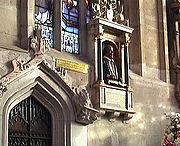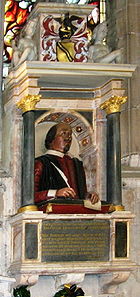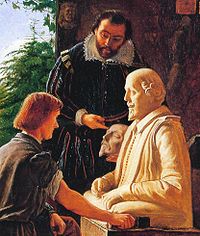
Shakespeare's funerary monument
Encyclopedia

William Shakespeare
William Shakespeare was an English poet and playwright, widely regarded as the greatest writer in the English language and the world's pre-eminent dramatist. He is often called England's national poet and the "Bard of Avon"...
located inside Holy Trinity Church
Holy Trinity Church, Stratford-upon-Avon
The Collegiate Church of the Holy and Undivided Trinity, Stratford-upon-Avon is a Grade I listed parish church of the Church of England in Stratford-upon-Avon, Warwickshire, England.-Background:...
, Stratford-upon-Avon
Stratford-upon-Avon
Stratford-upon-Avon is a market town and civil parish in south Warwickshire, England. It lies on the River Avon, south east of Birmingham and south west of Warwick. It is the largest and most populous town of the District of Stratford-on-Avon, which uses the term "on" to indicate that it covers...
, Warwickshire
Warwickshire
Warwickshire is a landlocked non-metropolitan county in the West Midlands region of England. The county town is Warwick, although the largest town is Nuneaton. The county is famous for being the birthplace of William Shakespeare...
, UK
United Kingdom
The United Kingdom of Great Britain and Northern IrelandIn the United Kingdom and Dependencies, other languages have been officially recognised as legitimate autochthonous languages under the European Charter for Regional or Minority Languages...
, the same church in which Shakespeare was baptised.
The monument, by Gerard Johnson
Gerard Johnson (sculptor)
Gerard Johnson is the Anglicised form of Gheerart Janssen, a sculptor who worked in Jacobean England and who is thought to have created Shakespeare's funerary monument....
, is mounted on the north wall of the chancel. It features a bust of the poet
Portraits of Shakespeare
Within four decades of its foundation in 1856, upwards of 60 portraits were offered for sale to the National Portrait Gallery purporting to be of William Shakespeare, but there are only two definitively accepted as portraying him, both of which are posthumous...
, who holds a quill pen in one hand and a piece of paper in another. His arms are resting on a cushion, a common motif in funerary monuments of the time. Above him is the Shakespeare family's coat of arms
Coat of arms
A coat of arms is a unique heraldic design on a shield or escutcheon or on a surcoat or tabard used to cover and protect armour and to identify the wearer. Thus the term is often stated as "coat-armour", because it was anciently displayed on the front of a coat of cloth...
, on either side of which stands two allegorical figures: one, representing Labour
Manual labour
Manual labour , manual or manual work is physical work done by people, most especially in contrast to that done by machines, and also to that done by working animals...
, holds a spade
Spade
A spade is a tool designed primarily for the purpose of digging or removing earth. Early spades were made of riven wood. After the art of metalworking was discovered, spades were made with sharper tips of metal. Before the advent of metal spades manual labor was less efficient at moving earth,...
, the other, representing Rest
Rest
Rest may refer to:* Leisure* Human relaxation* SleepRest may also refer to:* Rest , a pause in a piece of music* Rest , the relation between two observers* Rest , a 2008 album by Gregor Samsa...
, holds a torch
Torch
A torch is a fire source, usually a rod-shaped piece of wood with a rag soaked in pitch and/or some other flammable material wrapped around one end. Torches were often supported in sconces by brackets high up on walls, to throw light over corridors in stone structures such as castles or crypts...
and a skull
Human skull
The human skull is a bony structure, skeleton, that is in the human head and which supports the structures of the face and forms a cavity for the brain.In humans, the adult skull is normally made up of 22 bones...
.
It is not known exactly when the monument was erected, but it must have been before 1623; in that year, the First Folio
First Folio
Mr. William Shakespeares Comedies, Histories, & Tragedies. is the 1623 published collection of William Shakespeare's plays. Modern scholars commonly refer to it as the First Folio....
of Shakespeare's works was published, prefaced by a poem by Leonard Digges
Leonard Digges (writer)
Leonard Digges was an accomplished Hispanist and minor poet, a younger son of the astronomer Thomas Digges Leonard Digges (1588 – 7 April 1635) was an accomplished Hispanist and minor poet, a younger son of the astronomer Thomas Digges Leonard Digges (1588 – 7 April 1635) was an...
that mentions "thy Stratford moniment" [sic]. The monument was restored in 1748-9 and has been repainted several times.
Inscriptions
Beneath the bust is engraved a LatinLatin
Latin is an Italic language originally spoken in Latium and Ancient Rome. It, along with most European languages, is a descendant of the ancient Proto-Indo-European language. Although it is considered a dead language, a number of scholars and members of the Christian clergy speak it fluently, and...
epitaph and a poem in English
English language
English is a West Germanic language that arose in the Anglo-Saxon kingdoms of England and spread into what was to become south-east Scotland under the influence of the Anglian medieval kingdom of Northumbria...
. The Latin reads:
The first line translates as "A Pylian in judgement, a Socrates in genius, a Maro in art," comparing Shakespeare to Nestor
Nestor (mythology)
In Greek mythology, Nestor of Gerenia was the son of Neleus and Chloris and the King of Pylos. He became king after Heracles killed Neleus and all of Nestor's siblings...
the wise King of Pylus, to the Greek philosopher Socrates
Socrates
Socrates was a classical Greek Athenian philosopher. Credited as one of the founders of Western philosophy, he is an enigmatic figure known chiefly through the accounts of later classical writers, especially the writings of his students Plato and Xenophon, and the plays of his contemporary ...
, and to the Roman poet Virgil
Virgil
Publius Vergilius Maro, usually called Virgil or Vergil in English , was an ancient Roman poet of the Augustan period. He is known for three major works of Latin literature, the Eclogues , the Georgics, and the epic Aeneid...
(whose last name, or cognomen was Maro). The second reads "The earth buries him, the people mourn him, Olympus possesses him," referring to Mount Olympus
Mount Olympus
Mount Olympus is the highest mountain in Greece, located on the border between Thessaly and Macedonia, about 100 kilometres away from Thessaloniki, Greece's second largest city. Mount Olympus has 52 peaks. The highest peak Mytikas, meaning "nose", rises to 2,917 metres...
, the home of the Greek gods.
The English poem reads:
In modern orthography:
History

William Dugdale
Sir William Dugdale was an English antiquary and herald. As a scholar he was influential in the development of medieval history as an academic subject.-Life:...
's Antiquities of Warwickshire, published in 1656, in which the engraved illustration was copied, probably by Wenceslaus Hollar, from a rough drawing made by Dugdale. In Dugdale's depiction, the poet is not shown holding a quill or paper, and the cushion appears to be tipped up against his body. The art critic Marion Spielmann
Marion Spielmann
Marion Harry Alexander Spielmann was a prolific Victorian art critic and scholar who was the editor of The Connoisseur and Magazine of Art...
satirised the illustration, describing it as giving the impression that Shakespeare was pressing the cushion to his groin, "which, for no reason, except perhaps abdominal pains, is hugged against what dancing-masters euphemistically term the 'lower chest'". The print was copied by later engravers. In 1725, Alexander Pope
Alexander Pope
Alexander Pope was an 18th-century English poet, best known for his satirical verse and for his translation of Homer. He is the third-most frequently quoted writer in The Oxford Dictionary of Quotations, after Shakespeare and Tennyson...
's edition of Shakespeare's works included the first fairly accurate engraving of the monument, made by George Vertue
George Vertue
George Vertue was an English engraver and antiquary, whose notebooks on British art of the first half of the 18th century are a valuable source for the period.-Life:...
in 1723. A drawing of the monument in situ by Vertue also survives.
The monument was restored in 1748-9. Parson Joseph Greene, master of Stratford grammar school, organised the first known performance of a Shakespeare play in Stratford to fund the restoration. John Ward's company agreed to perform it. Records do not say which play it was, but B.C.A. Windle, writing in 1899, states that it was Othello
Othello
The Tragedy of Othello, the Moor of Venice is a tragedy by William Shakespeare, believed to have been written in approximately 1603, and based on the Italian short story "Un Capitano Moro" by Cinthio, a disciple of Boccaccio, first published in 1565...
.
Greene wrote that "the figure of the Bard" was removed to be "cleansed of dust &c". He noted that the bust and cushion was carved from a single piece of limestone. He added that "care was taken, as nearly as could be, not to add to or diminish what the work consisted of, and appear’d to have been when first erected: And really, except changing the substance of the Architraves from alabaster to Marble; nothing has been chang’d, nothing alter’d, except supplying with original material, (sav’d for that purpose,) whatsoever was by accident broken off; reviving the Old Colouring, and renewing the Gilding that was lost”. Greene also had a plaster cast of the head made at this time.
Shakespeare's pen has been repeatedly stolen and replaced since, and the paint has been renewed. In 1793 Edmund Malone, the noted Shakespeare scholar, persuaded the vicar to paint the monument white, in keeping with the Neoclassical taste of the time. The paint was removed in 1861 and the monument was repainted in the colours recovered from underneath the white layer.
In 1973 intruders removed the bust from its niche, chipping it out. Local police took the view that they were looking for valuable Shakespeare manuscripts, which were rumoured to be hidden within the monument. According to Sam Schoenbaum, who examined it after the incident, the bust suffered only "very slight damage".
Interpretations

Richard Owen
Sir Richard Owen, FRS KCB was an English biologist, comparative anatomist and palaeontologist.Owen is probably best remembered today for coining the word Dinosauria and for his outspoken opposition to Charles Darwin's theory of evolution by natural selection...
that Johnson probably used a death mask
Death mask
In Western cultures a death mask is a wax or plaster cast made of a person’s face following death. Death masks may be mementos of the dead, or be used for creation of portraits...
discovered in Germany by Ludwig Becker in 1849, known as the Kesselstadt Death-Mask, to make the bust. The mask had been claimed to be of Shakespeare because of a similarity to an alleged Shakespeare portrait Becker had bought two years earlier. This was depicted by the painter Henry Wallis
Henry Wallis
Henry Wallis was an English Pre-Raphaelite painter, writer and collector.Born in London on 21 February 1830, his father's name and occupation are unknown. When in 1845 his mother, Mary Anne Thomas, married Andrew Wallis, a prosperous London architect, Henry took his stepfather's surname. His...
in his imaginary scene portraying Ben Jonson
Ben Jonson
Benjamin Jonson was an English Renaissance dramatist, poet and actor. A contemporary of William Shakespeare, he is best known for his satirical plays, particularly Volpone, The Alchemist, and Bartholomew Fair, which are considered his best, and his lyric poems...
showing the death mask to the sculptor. However, measurements of the mask and the monument bust did not correspond, most notably the bony structure of the forehead, and the idea was discredited.
Critics have generally been unkind about the appearance of the sculpture. Thomas Gainsborough
Thomas Gainsborough
Thomas Gainsborough was an English portrait and landscape painter.-Suffolk:Thomas Gainsborough was born in Sudbury, Suffolk. He was the youngest son of John Gainsborough, a weaver and maker of woolen goods. At the age of thirteen he impressed his father with his penciling skills so that he let...
wrote that "Shakespeare's bust is a silly smiling thing". J. Dover Wilson
J. Dover Wilson
John Dover Wilson CH was a professor and scholar of Renaissance drama, focusing particularly on the work of William Shakespeare...
, a critic and biographer of Shakespeare, once remarked that the Bard's effigy makes him look like a "self-satisfied pork butcher." Sir Nikolaus Pevsner
Nikolaus Pevsner
Sir Nikolaus Bernhard Leon Pevsner, CBE, FBA was a German-born British scholar of history of art and, especially, of history of architecture...
pointed out that the iconographical
Iconography
Iconography is the branch of art history which studies the identification, description, and the interpretation of the content of images. The word iconography literally means "image writing", and comes from the Greek "image" and "to write". A secondary meaning is the painting of icons in the...
type represented by the bust is that of a scholar or divine; his description of the effigy is "a self-satisfied schoolmaster".
Schoenbaum, however, says the monument is a typical example of Jacobean Renaissance style, and Spielmann says the "stiff simplicity" of the bust was more suitable for a sepulchral sculpture in a church than a more life-like depiction.

